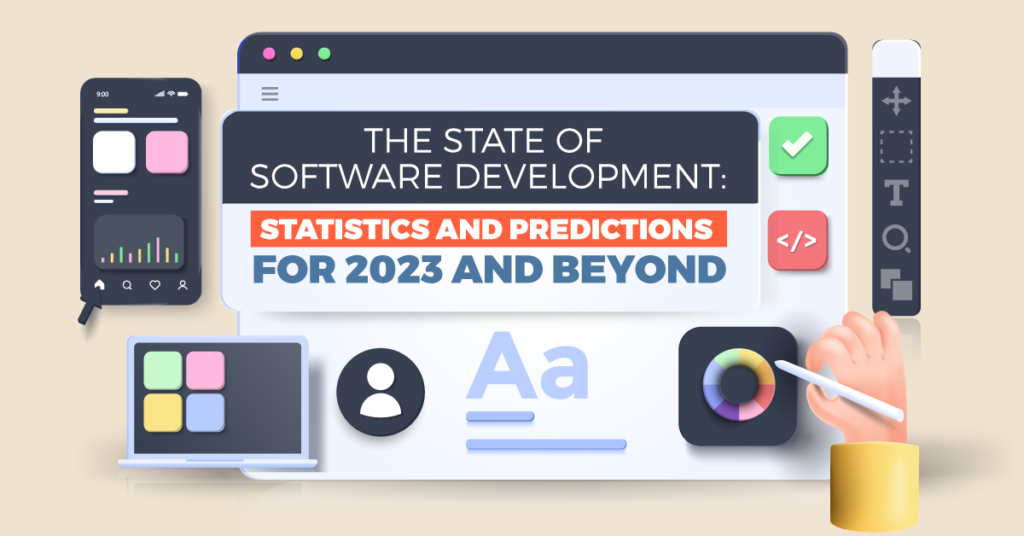
Technological innovations have become integral for businesses as they help increase productivity and cut costs to support growth. As such, staying up-to-date with software development trends lets your company remain competitive in an ever-changing business landscape.
Read below to know more about future predictions and statistics on software development.
The State of Software Development: Statistics and Predictions for 2023 and Beyond

Software Development by the Numbers
1. The global number of software developers may reach 28.7 million by 2024. (Statista)
Technology has become more integrated into daily activities, whether personal or professional. As a result, businesses across industries have seen the need to adapt to remain competitive, with the demand for professionals with the necessary skills increasing.
The population of software developers will reach 28.7 million by 2024, a 3.2 million increase from the 2020 numbers. This demand creates new opportunities for software developers, incentivizing many to pursue this career.
2. Software market revenue may reach $12.90 billion by 2027, with a CAGR of 5.72% from 2023 to 2027. (Statista)
Many companies have started their digital transformation, using technology to improve operations’ efficiency and efficacy. According to Statista, the enterprise software segment of the market holds the largest share. Software development statistics project that this market will reach $263.80 billion in 2023.
When it comes to digitalization, automation and data analytics are at the top of the list. As such, software that can automate processes and provide better data insights has become more sought-after than ever.
3. The projected market value of the IT outsourcing industry for 2023 is $430.50 billion. (Statista)
Outsourcing—including the IT outsourcing market—has become prevalent in recent years, giving companies that lack skilled labor supply in this profession several benefits.
Enlisting the services of an offshore software development team allows you to leverage a wider pool of experts who can handle your tech efficiently. Moreover, it lets your in-house team focus on critical tasks for your business’s growth. This way, you can ensure that operations run smoothly while your team prepares for future development.
4. Projections show a CAGR for the IT outsourcing industry of 8.07% from 2023 to 2027, leading to a market value of $587.30 billion. (Statista)
Software development statistics show great potential to increase profitability for IT outsourcing. The rise in technology use and digital transformation has paved the way for new services clients can outsource. Moreover, outsourcing IT tasks can cut costs, which can be part of the reason for the market’s potential growth.
For example, you can reduce overhead costs while overcoming IT challenges by getting an outsourced team. You won’t have to spend resources on training new hires or adding another expense to your payroll. This benefit becomes a practical cost-saving money strategy that you can leverage.
5. Forecasts on outsourcing software development in startup companies see a 70% increase from 2022 to 2023. (Commit)
Startups can gain from offloading some of their business functions to outsourcing companies. Recruiting top-quality talent requires significant resources. However, startups may not have enough resources to do so, which may pose a problem for those with growth potential but cannot scale up quickly.
Startups can catch up to their growth with outsourcing. It enables them to scale up quickly by giving them access to IT experts that may otherwise be costly if maintained in-house. On top of this, they can access cutting-edge technologies and networks to improve their operations and stay updated with the trends.
Top Tools of the Trade
The top 5 programming languages for 2023 are Python, C, C++, Java, and C#. (TIOBE)
These five programming languages are versatile and have extensive libraries and frameworks. Developers can use them in various applications like desktop and mobile platforms, web development, game development, and artificial intelligence (AI). These features allow developers to simplify the code-writing process and quicken app creation.
Thanks to these benefits, these languages have amassed large communities, contributing to their enhancements and supporting fellow developers. Having these programming languages in your arsenal can give developers an advantage in a competitive market.
In terms of the web framework, most developers worldwide use Node.js (47.12%), followed by React.js (42.62%), jQuery (28.57%), Express (22.99%), and Angular (20.39%). (Statista)
The primary purpose of a web framework is to simplify the web development process by automating routine tasks. This way, developers can build a website without repetitive and time-consuming activities, making the process more efficient and less tedious.
Node.js is the most-used web framework due to its ease of use, scalability, and high performance. This framework eliminates the need to learn a new programming language by letting developers write server-side codes using JavaScript and enabling speedy large-scale web app developments.
Amazon Web Services (32%), Microsoft Azure (23%), and Google Cloud (10%) were the top vendors in the cloud infrastructure services market in the last quarter of 2022. (Statista)
Following the transition to an online environment, cloud computing services have become in demand. Companies rely on cloud vendors to enable their operations online. Whether staying compliant or gathering insights with data analytics, cloud computing has proven helpful for many businesses.
However, continuous tech advancements open up new complex problems. Cloud vendors must innovate and create offers that can meet these demands. Amazon Web Services (AWS) fulfills these needs by providing agility, reliability, and security through its cloud services. Consequently, they have dominated the market, holding 32% of the shares in 2022.
Besides AWS, the major players in the cloud infrastructure services market are Microsoft Azure and Google Cloud. All in all, the top three cloud vendors take up 65% of the market.
The Future of Software Development
1. Continuous adoption of Artificial Intelligence and Machine Learning
According to Fortune Business Insights, future predictions for software development values the AI market at $1,394.30 billion in 2029—up from $387.45 billion in 2022. Undoubtedly, AI has played a significant role in accelerating digital transformation and innovations. Organizations worldwide have invested in this technology to improve operations at a low cost.
Moreover, continuous developments in 5G deployment, cloud computing, automation, and large databases have increased AI demand. With the current stats, the AI market sees a CAGR of 20.1% in the 2022–2029 forecast period.
2. Focus on building secure software
Gartner estimates that in 2023, risk management and information security expenditures will hit $188.336 billion.
With the increased integration of the online world, organizations have started operating in multi-cloud environments. This shift to a connected operating environment can increase security risks and complex technology needs. As such, companies have adopted cloud security solutions, pushing the growth of this market segment.
3. Widespread implementation of the Internet of Things (IoT)
Future predictions for software development estimate that the IoT market will experience an 18% increase in 2023 with over 14 billion active connections. Statistics also show that connected devices will reach over 27 billion in 2025.
Many factors can contribute to the rise in IoT. The increase in demand for smart homes and cities may add to the total as these require connected devices for a seamless living experience. On top of this, the continued rise of work-from-home and remote setups can contribute to the IoT markets’ increased connections.
4. Increased use of low-code and no-code development platforms
According to Gartner, organizations will develop 70% of their new applications using low-code or no-code platforms—up from less than 25% last 2020.
Organizations can keep up with the ever-changing business landscape and solve problems immediately by expediting software development projects. However, a shortage of skilled software developers may pose another difficulty since developing an application can take time.
Due to this, low-code and no-code platforms have become popular. Instead of relying solely on the IT department, concerned teams can create simple applications for internal use with low-code and no-code platforms, freeing up time and investment for more sophisticated software that developers can do.
5. Continuing dominance of cloud software
Gartner reports that organizations will deploy around 95% of new digital workloads on cloud-native platforms by 2025. The cloud continuously proves to be a necessary asset for many business processes. On top of scalability, companies can use the cloud to accelerate innovation while lowering costs through streamlined processes. As such, they can ensure business agility that keeps up with the trend.
With cloud software cementing itself as a critical tool, businesses can expect new roles and responsibilities to emerge.
6. Introduction of new programming languages and tech stacks
For 2023, experts recommend enhancing your programming skills by adding new-generation languages, such as F#, Crystal, PureScript, Pony, and Dart, to your tech stack. The current programming languages may not be the perfect fit for most development projects. Accordingly, new-generation languages have emerged to fill in the gaps.
By design, these languages can enhance speed optimization, allow scalability, and facilitate effortless mastery for new users. For example, the new programming languages are all statically typed for a smoother development experience. Additionally, they are open-source—anyone can view, modify, or distribute their source code without hassle.
7. Rapid adoption of edge computing in software development
The edge computing industry can expect its value to increase to $28.84 billion in 2025 from $1.46 billion in 2018. This technology provides an improved user experience, cost savings, and better control over resource consumption. For example, edge computing can transfer features directly onto a user’s device, appealing to privacy-focused customers.
Furthermore, it supports businesses in adhering to security regulations while offering modern cloud-based features.
Leverage Technology for a Competitive Edge
Technological advancements and innovations continue to shape today’s business landscape. From adopting new technologies to enhancing existing software, companies look to these solutions to cut costs, improve productivity, and enable business growth. As such, keeping tabs on current software development trends lets you do all those things and stay ahead of the competition.
Enhance your business operations with technology and the best IT personnel. Manila Recruitment is a recruitment agency in the Philippines that can help you find the best remote and offshore IT for your software development needs.
Contact us today to know more.













